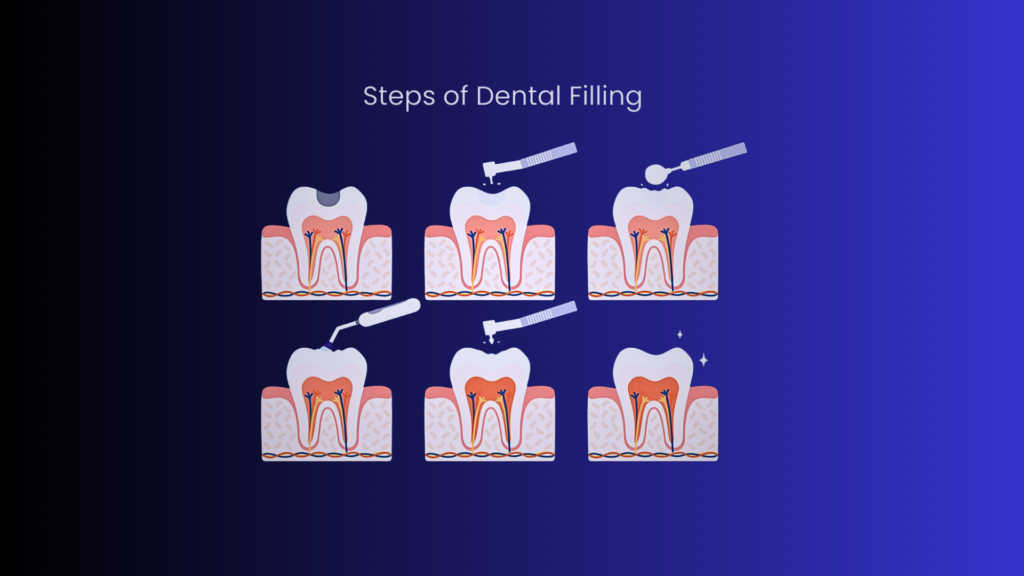How much do fillings cost in Turkey?

Dental Filling Applications
Dental fillings are procedures performed to remove tissues that disrupt the function and structural integrity of the tooth, such as abrasion and decay, and replace them with special materials to improve dental function and aesthetics.
Different materials can be used in dental fillings for the treatment of decayed, cracked, fractured, and abraded teeth. The choice of filling material is determined by the patient and the dentist during the filling procedure.

Which Materials are Used in Dental Fillings?
With the increasing importance of aesthetic appearance today, aesthetic filling materials that match the natural color of the tooth are often preferred. Gold fillings, amalgam fillings, composite fillings, or porcelain fillings can be used in dental fillings.
The choice of filling material is determined based on the patient’s specific needs and expectations. Each filling material has different characteristics. For example, gold fillings can last for more than 20 years but are the most expensive option. Similarly, amalgam fillings are highly resistant to wear but do not provide an aesthetic solution. In recent years, composite fillings have become more preferred due to their natural appearance.
Types of Dental Fillings
Amalgam Fillings: Also known as metal fillings. Amalgam is obtained by the reaction of silver, tin, and copper alloys with mercury. Mercury binds the metals together to create a durable filling material.
The mercury in the filling is not toxic and becomes harmless when combined with other metals. The amount of mercury is much less than what we are exposed to in our daily lives, such as the amount obtained from water, air, and food. Amalgam fillings are the most long-lasting, durable, and easy-to-apply type of filling.
When Are Amalgam Fillings Applied?
- In patients without mercury or metal allergies,
- In patients having difficulty controlling saliva,
- In teeth with extensive and deep decay (tissue loss),
- In areas where excessive chewing forces may occur, such as heavily decayed back teeth.
After the application of amalgam fillings, it is recommended not to chew for 2 hours and to avoid consuming hard and sticky foods in the treated area for the next 24 hours. A polishing procedure is performed 24 hours later to prolong the life of the filling and eliminate any excess height. Short-term hot-cold sensitivity may occur in the relevant tooth after the application of amalgam fillings in deep decay.
Composite Fillings: Composite fillings are aesthetic filling materials that are produced as an alternative to amalgam fillings, bond to the tooth’s hard tissue with the help of a bonding agent, have a wide range of color options, and have been used for many years.
Composite fillings are placed layer by layer onto the tooth, and each layer is cured with light. They are shaped and corrected according to the tooth, and a polishing procedure is performed in the same session. Due to their aesthetic appearance and ease of application, they are preferred as filling materials for the front teeth.
Composite fillings play a significant role in modern conservative dentistry. Composite applications are more economical compared to porcelain and gold fillings, and they are a filling technique that requires only one session.
The composite material used in composite fillings is not as hard as natural tooth enamel. It can be damaged by nail-biting, hard foods, and biting on pens. The lifespan of the filling varies depending on your oral habits and the size of the filling.

How Are Composite Fillings Applied?
Composite fillings are applied by applying a paste-like composite material that matches the tooth color after the removal of tooth decay, shaping it, and then curing it with a light device. After the filling material hardens, the excess height is adjusted. The finishing process gives the filling an anatomical shape. Then, the tooth surface is polished until it shines like other surfaces. The completion of the procedure takes approximately 30 minutes to an hour.
After the composite procedure, for the first 48 hours, substances that can cause stains, such as tea, coffee, and cigarettes should not be consumed. In addition, regular brushing of your teeth and dental check-ups are necessary.

Porcelain Fillings: Inlays, Onlays, and Endocrowns
Porcelain fillings are fillings with superior aesthetics and durability prepared with CAD-CAM systems in a laboratory environment. Compared to composite fillings, they are much more compatible with the tooth they are applied to and adjacent teeth.
After the broken, decayed, or old-filled part of the tooth is removed, a digital measurement of the remaining healthy part is taken, and perfect aesthetic and functional fillings are prepared with precise technology. The most advanced technology is used in the preparation of these porcelain fillings, and the healthy tooth structure in the mouth is not touched, providing maximum retention with minimum material loss.
Since porcelain fillings are made of a compressed special porcelain that is not hardened in the mouth, the marginal leakage is minimal. Moreover, these porcelains are closest to the hardness of the tooth and most compatible with the gum tissue. Since their hardness is very similar to the enamel tissue of the tooth, they do not erode the teeth like other porcelains, and they do not get eroded like composite fillings. They are preferred especially in cases of significant material loss, instead of composite fillings or veneers.
How is Dental Filling Done?
During a dental filling, the problem in the tooth is identified. If the filling is to be performed due to decay, the decayed part of the tooth needs to be removed first. Local anesthesia can be preferred during the filling procedures, depending on the depth of the decay. Local anesthesia is not necessary for very superficial decay. Once the decay is completely removed, the cavity in the tooth is filled with the selected filling material using a special instrument.
What are the Benefits of Dental Fillings?
Dental fillings are a procedure that involves the removal of worn and structurally damaged parts of the tooth and strengthens the tooth. Depending on the choice of filling material, dental fillings can resolve aesthetic concerns.
Filling applications are quite long-lasting. Depending on the type of filling material chosen and the amount of care the patient gives to oral care, it can be said that these fillings last for at least 5 years.
The discomfort and pain caused by decay disappear with the filling procedure. This increases the chewing capacity of patients and prevents pain. Filling procedures (temporary) especially prevent the formation of infections when long-term treatments such as root canal therapy are required.
Dental fillings restore the functions of the teeth, prevent the spread of decay, and help prevent tooth loss.


